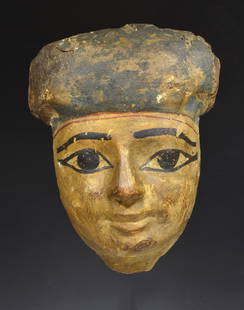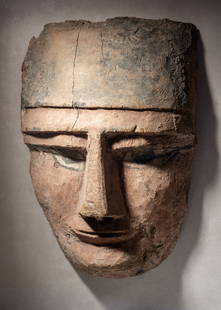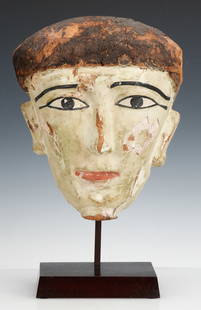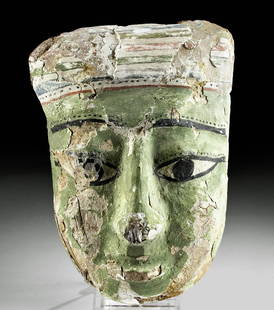
Egyptian TIP Wood Sarcophagus Mask
Similar Sale History
View More Items in MasksRelated Masks
More Items in Masks
View MoreRecommended Art
View More




Item Details
Description
Ancient Egypt, Third Intermediate Period, 21st to 25th Dynasty, ca. 1070 to 664 BCE. An elegant hand-carved mummy mask with a square headdress and delineated neck enveloped in impressive remains of white gesso and black pigment. The attractive visage is symmetrically oriented, with almond-shaped eyes, prominent raised eyelids, and elongated canthi, a naturalistic nose, full lips in a petite smile, and gently arched brows beneath a squat forehead. Five dowels remains on the headdress, cheeks, and underside of chin, while several dowel holes are present on the verso and peripheries. Size: 3.9" L x 5.7" W x 10.7" H (9.9 cm x 14.5 cm x 27.2 cm); 13.5" H (34.3 cm) on included custom stand.
Interestingly, cedar wood was not native to Egypt. Egypt did not have verdant forests filled with tall trees, and unfortunately most of its native lumber was of relatively poor quality. Thus, they relied on importing to acquire hardwoods - ebony imported from Africa, cedar and pine from Lebanon. One fabulous obelisk inscription by Thutmose III attests to the luxury of treasured hardwoods. It reads as follows, "They brought to me the choicest products...consisting of cedar, juniper and of meru wood...all the good sweet woods of God's Land." The rarity of cedar meant that masks like this example were reserved for those who could afford them.
Ancient Egyptians believed it was of the utmost importance to preserve a body of the deceased, because the soul needed a place to reside after the death. Preservation of the body was done via mummification - a process involving the removal of internal organs that were placed in canopic jars, wrapping the body in linen, and then embalming. Death masks like this example were created so that the soul could recognize the body and return to it. For this reason, death masks were made in the likeness of the deceased. Artisans used different materials. Earlier masks were carved from wood. Later, cartonnage, a material made from papyrus or linen and soaked in plaster which was then applied to a wooden mold, was used. Royal death masks, perhaps the most famous being that of Tutankhamen, were made from precious metals. All death masks were intended to resemble the deceased subject; however, eyes were always slightly enlarged and lips presented in a subtle smile as we see in this example.
Provenance: private New York, New York, USA collection; ex-Joanna Barnes and Jack Warner estate, Santa Barbara, California, USA, acquired before 2012
All items legal to buy/sell under U.S. Statute covering cultural patrimony Code 2600, CHAPTER 14, and are guaranteed to be as described or your money back.
A Certificate of Authenticity will accompany all winning bids.
We ship worldwide to most countries and handle all shipping in-house for your convenience.
#183901
Interestingly, cedar wood was not native to Egypt. Egypt did not have verdant forests filled with tall trees, and unfortunately most of its native lumber was of relatively poor quality. Thus, they relied on importing to acquire hardwoods - ebony imported from Africa, cedar and pine from Lebanon. One fabulous obelisk inscription by Thutmose III attests to the luxury of treasured hardwoods. It reads as follows, "They brought to me the choicest products...consisting of cedar, juniper and of meru wood...all the good sweet woods of God's Land." The rarity of cedar meant that masks like this example were reserved for those who could afford them.
Ancient Egyptians believed it was of the utmost importance to preserve a body of the deceased, because the soul needed a place to reside after the death. Preservation of the body was done via mummification - a process involving the removal of internal organs that were placed in canopic jars, wrapping the body in linen, and then embalming. Death masks like this example were created so that the soul could recognize the body and return to it. For this reason, death masks were made in the likeness of the deceased. Artisans used different materials. Earlier masks were carved from wood. Later, cartonnage, a material made from papyrus or linen and soaked in plaster which was then applied to a wooden mold, was used. Royal death masks, perhaps the most famous being that of Tutankhamen, were made from precious metals. All death masks were intended to resemble the deceased subject; however, eyes were always slightly enlarged and lips presented in a subtle smile as we see in this example.
Provenance: private New York, New York, USA collection; ex-Joanna Barnes and Jack Warner estate, Santa Barbara, California, USA, acquired before 2012
All items legal to buy/sell under U.S. Statute covering cultural patrimony Code 2600, CHAPTER 14, and are guaranteed to be as described or your money back.
A Certificate of Authenticity will accompany all winning bids.
We ship worldwide to most countries and handle all shipping in-house for your convenience.
#183901
Condition
Chipping and losses to sides of headdress, as well as some stable fissures to wood. Chipping and wear to raised areas such as chin and nose, and some nicks and abrasions to surface as shown, all commensurate with age. Otherwise, impressive presentation with nice remains of pigments. Original dowel holes visible on verso and peripheries with 5 dowels remaining on underside of chin, front of headdress, and cheeks. Affixed to stand via metal screws.
Buyer's Premium
- 27.5%
Egyptian TIP Wood Sarcophagus Mask
Estimate $5,500 - $7,750
4 bidders are watching this item.
Get approved to bid.
Shipping & Pickup Options
Item located in Louisville, CO, usShip with LiveAuctioneers
Local Pickup Available
Arrange Your Own Shipping
Payment
Accepts seamless payments through LiveAuctioneers

Auction Curated By

Owner/Executive Director, Antiquities & Pre-Columbian Art

PhD. Art History, Director, Fine & Visual Arts
TOP





















































































